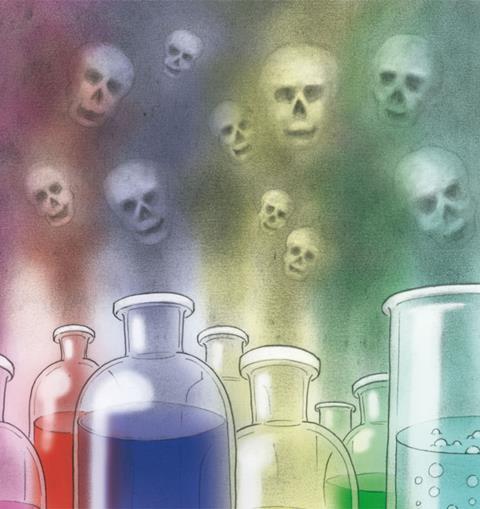How do you reconcile the need for personal safety with unfamiliar compounds, asks Derek Lowe

Let’s start out with a confession. It’s a minor sin, perhaps, but a real one. I have, in the past, enjoyed myself a bit with non-chemists by talking about some of the more lively and hazardous reagents that I’ve worked with (or in some cases, have refused to work with). My story about the time a sulfenyl chloride disproportionated on me, just before I picked up the recently-pressurised flask and held it in my hand, always grabs the audience’s attention. (It certainly grabbed mine when it happened.) And there are plenty more where that one came from. My mental file drawer labelled ‘Terrible Reagents I Have Known’ is even larger than the one called ‘Lunatics I Have Worked With and their Life-Threatening Ideas’.
But I don’t have to exaggerate the toxicity or reactivity of any of the compounds in that file. The truth about them is suficient. We organic chemists really do work with some terrible chemicals, and it’s up to us to keep them from causing havoc. People really do get injured, poisoned, or sometimes even killed using such things, so it’s worth asking how chemists work while knowing about these cases – and asking, as well, if there are reagents that are just not worth the risk at all.
I think most chemists, when they read most accident reports, think to themselves ‘Well, of course – I wouldn’t have done it that way’. Sometimes that response is completely justified. There are accidents that just elicit groans, such as an incident with a summer undergraduate student working with an old colleague of mine. This worthy experimentalist managed to carve off the required amount of sodium with a small knife, while firmly gripping the block of metal with his other bare hand. It’s not hard to feel some reassurance at such cases, which is one of the lesser-known reasons that these stories get told so often. But there are other, more disturbing tales that don’t provide any room to feel superior. Karen Wetterhahn’s death at Dartmouth from a seemingly trivial spill of dimethylmercury – onto a gloved hand – is one of the most famous examples.
The main thing one takes from a story like that is a fierce determination never to work with dimethylmercury. That’s not a bad lesson by itself, but it leaves open the possibility that there are other such hazards waiting unknown. The chances of these are low, but not zero, as the famous example of MPTP (1-methyl-4-phenyl-1,2,3,6-tetrahydropyridine) shows. That compound, which is a perfectly plausible small intermediate for a medicinal chemist to make, causes irreversible Parkinson’s disease on exposure, and (alarmingly) this was not an effect that anyone could have predicted by looking at its structure. It’s the result of a terrible cascade: the compound is metabolised readily to a reactive intermediate that happens to be an excellent substrate for a transporter protein – and then also happens to be an excellent inhibitor of a key metabolic enzyme. One could not have designed a better small molecule to kill off dopamine rich neurons. The thought of how many other such compounds might be waiting out there does not make for a restful evening.
Safety spectrum
These examples serve to show that there are compounds that many – if not most – chemists just will not work with. I would not use either dimethylmercury or MPTP. No single reaction I have is important enough for me to take the risk. There are other things I can make, and other ways that I can make them, and it’s not very likely, fortunately, that any drug intermediate is going to be made using dimethylmercury. (I imagine that the scale-up group would come for me with knives drawn. Even if I survived my own chemistry, I’d have them to deal with.) Others have used it in the past without being harmed, of course, but I have no desire to see if my lab technique is sound enough to add my name to their list, for fear of ending up on another list entirely.
The only thing to do is: exercise due caution. I know from my own experience that most of the compounds I make don’t seem to do very much to enzymes and cells. The odds of my inadvertently producing an efficient poison are low, but that doesn’t mean that I shouldn’t work in the fume hood and keep my hands clean. That said, if I were to treat every new compound I make as if it were MPTP, I wouldn’t get very much work done, would I? There’s a middle ground, and it’s up to every bench chemist to find a place in it. Knowing as many of the already-discovered hazards as possible is a good place to start, and probably gives the greatest return in safety for the effort.












No comments yet